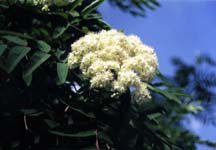21. Crassulaceae - Stonecrop; succulent herbs and subshrubs; leaves alternate or opposite, simple, fleshy, lacking stipules; vegetative reproduction common from rhizomes, offsets, and bulbils; flowers perfect usually; sepals 4-5 (to many), free; petals as many as sepals, separate or united; stames as many or twise as many as petals; carpels 3-several, free or basally united, each subtended by a glandular scale.
22. Saxifragaceae - Herbs; leaves alternate, basal, lacking stipules; flowers perfect, in racemose or cymose inflorescences, rarely solitary; sepals 5, petals 5, often clawed; stamens 5 or 10; flowers perigynous.
23. Rosaceae - Herbs, shrubs, and trees; leaves with stipules; flowers actinomorphic; sepals 5, petals 5; stamens numerous; hypanthium (floral disk) often present.













24. Fabaceae (Leguminosae) - Bean, pea; trees, shrubs, or herbs; leaves pinnately or palmately compound or simple; flowers papilionaceous and distinctly irregular; corolla of 5 petals forming a banner (or standard), 2 wings, and a keel; stamens 10 ( all free, 9 fused and 1 free, or all 10 fused); pistil of 1 carpel; fruit a legume.
25. Onagraceae - Evening primrose; herbs; flowers 4-merous, rarely 2-merous; hypanthium present, and on its rim are inserted sepals, petals, and stamens; ovary inferior.
26. Viscaceae - Mistletoe; parasitic shrubs of tree branches; leaves usually opposite, leathery, veins parallel; flowers small, perfect or imperfect; perianth of 2-4 tepals, inserted on a cup-shaped receptacle; stamens as many as perianth segments; ovary inferior; ovules seemingly absent; fruit a drupe or berry, with a viscous layer within the vascular bundles.
27. Euphorbiaceae - Spurge; herbs, shrubs, trees or lianas; many are xerophytic and cactoid; most with milky latex; leaves alternate, sometimes opposite or whorled, simple or compound, usually with stipules, but often modified into glands, hairs, or spines; flowers imperfect, plants often monoecious; sepals and petals present or either or both lacking; fruit a schizocarp.
28. Aceraceae - Maple; trees or shrubs; leaves opposite, usually simple with palmate venation; flowers actinomorphic; fruit a winged schizocarp.
29. Anacardiaceae - Cashew, poison ivy; trees or shrubs; flowers 5-merous; stamens inserted beneath a disc surrounding the ovary; ovary unilocular.
30. Oxalidaceae - Sorrel; mostly herbs, rarely trees; often with fleshy tubers or rhizomes; leaves alternate, pinnately or palmately compound, or simple by reduction, lacking stipules; often with acrid taste; flowers perfect, in umbellate inflorescences; sepals 5, separate; petals 5, separate or united at base; stamens 10, outer whorl opposite the petals, monadelphous (filmants fused); fruit usually a loculicidal, elastically explosive capsule, rarely a berry.
31. Geraniaceae - Geranium; flowers 5-merous, stamens with filaments united at base; fruit with elastic dehiscent schizocarps that curl on the beak.
32. Balsaminaceae - Touch-Me-Not; succulent herbs with translucent, watery stems; leaves alternate or opposute, lacking stipules; flowers perfect, zygomorphic, solitary to subumbellate; flowers with 3 or 5 unequal sepals, lowermost forming a tubular spur; petals 5, lateral pair united; stamens 5, united above, forming a cap over the pistil; carpels 5, united; fruit an explosively dehiscent capsule or rarely a berry.
33. Apiaceae (Umbelliferae) - Carrot, parsely; aromatic herbs with hollow stems; leaves compound with sheathing bases; inflorescences umbellate; flowers 5-merous, often yellow or white; stamens 5, ovary 2-carpellate, bilocular, inferior; fruit a schizocarp.
| TOP (Index Page) |
| Previous Subclass | Next Subclass |
| Magnoliidae | Hamamelidae | Caryophyllidae | Dilleniidae | Rosidae | Asteridae |
| Alismatidae | Arecidae | Commelinidae | Zingiberidae | Liliidae |